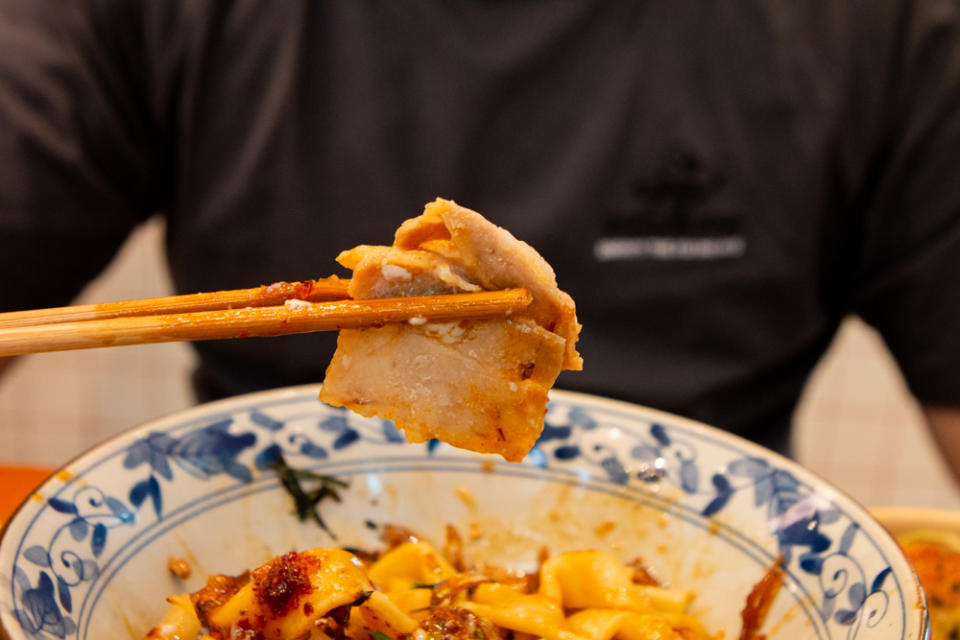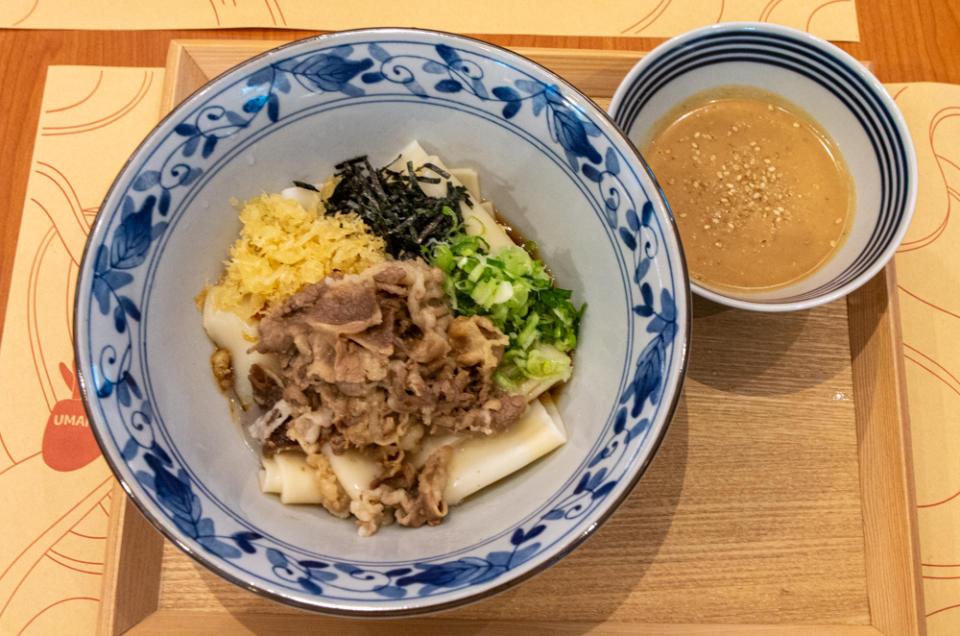Umai Artisanal Udon Bar: Viral Tokyo flat udon & 20+ other udon dishes under 1 roof
Forget ramen, udon has my wholehearted vote whenever anyone pops the question about the superior Japanese noodle form. Thick and chewy, what’s not to love about it?
Needless to say, I was thrilled when Umai Artisanal Udon Bar made the rounds on social media; I had to go!

Helmed by the same team behind the renowned chirashi-donburi brand Omoté, Umai is Singapore’s first specialty udon bar. It opened its doors just this year on 16 Jan and is located in the heart of central Singapore at Guoco Midtown.

Umai utilises 4 unique types of handcrafted udon noodles, all proudly displayed at the shopfront.
Originating from various parts of Japan, the udon types differ in texture, thickness and shape. They include the Sanuki type which we’re most familiar with, the thin Hippari, the flat and thick Hoto and the ultra-wide Himokawa.
Fun as the idea is, you can’t customise your own udon bowl – the noodle type comes pre-decided.
Regardless, I was spoilt for choice with a menu that boasts over 20 udon-centric items, including interesting fusion-style offerings like Spicy Basil Pork (S$17++) and Miso Carbonara (S$19++).
What I tried at Umai Artisanal Udon Bar

It’s no secret that I’m huge on ban mian; I mean, it’s written all over my work here. Naturally, I headed straight for the Chilli Pan Mee.
For S$15++, this might’ve been the most expensive bowl of ban mian I’d probably ever find myself paying for. But, as we all comfort ourselves – good food is always worth an occasional splurge.

The bowl arrived looking like a zhng-ed up version of chilli ban mian. A colourful plethora of ingredients concealed the bed of udon noodles.
It was evident that these weren’t your typical ban mian ingredients. On top of the usual minced meat, chilli paste and ikan bilis, the bowl sported an onsen egg, slices of black pork, tempura and bonito flakes.

The thick and flat Hoto noodles are used here to emulate ban mian in terms of looks and texture.
Sure enough, they nailed the QQ texture; the noodles were springy and soft, but not mushy in the least! It hit all the right spots, instantaneously contending for the title of my favourite udon.
The sauce mixture was composed of a caramelised clam sauce and a spicy shrimp aioli emulsion.
To my surprise, both elements were distinctly pronounced. The sweetness of the caramelised clam was complemented well by the savoury hae bee hiam-esque aioli, making for a perfect umami balance with an added kick from the dollop of chilli paste.

I did also find the ingredients used to be of high quality, and especially enjoyed the black pork slices. They did not have an overpowering gamey-ness, instead possessing a clean taste that went well with the moreish sauce.
The mild brine of the seaweed and light smokiness of the bonito flakes wonderfully tied together this fusion of Japanese and Chinese flavours.

I was most excited to try my second dish, the Himokawa Udon with Niku Shabu. I opted to have it cold, although you can go for the hot, soupy version instead.
The noodles are garnished with pieces of beef shabu, tempura flakes, seaweed and spring onion, and are accompanied by a bowl of sesame dipping sauce.
I got the dish in a Deluxe Set (S$25++), which entitled me to a tempura platter on the side. An a la carte option without tempura is also available for S$18++.
Himokawa udon is widely known as the viral “flat udon” made popular by Tokyo-based udon restaurant Godaime Hanayama and its snaking queues. Having dreamed about getting to taste it one day, I was stoked that I’d get my chance to do so right here!

Each Himokawa udon strand was indeed wide, with a mild translucency and thinness akin to that of kway chap.
The noodles were cold and immensely refreshing, reminding me of the experience of eating cha soba. Texture-wise, they were toothsome but weren’t as chewy as the Hoto variation.
Though the peanut sauce looked thick, it was surprisingly light. They coated the dipped noodles in a pleasantly sweet, nutty layer complemented by the added crunch of peanuts.

My Deluxe Set came with an assortment of tempura, including okra, ebi, carrots and eggplant.

Though the tempura pieces weren’t outstanding, I commend that they were lightly battered and not oily at all.
However, I did feel that the selection of tempura here isn’t the most suited for all palates. If you’re picky or would rather go for crowd favourites, I’d suggest skipping the Deluxe Set.

As a lover of Japanese croquettes and all things creamy and cheesy, I couldn’t leave without trying the Truffle Korokke (S$6++).

This dish was a stunner – the crisp, golden-brown snow crab croquette sat on a bed of classic Japanese sesame salad, proudly oozing a creamy filling that I could stare at all day.
Of course, I thoroughly enjoyed the filling. It had a mellow sweetness from the snow crab, complemented by the pronounced yet not overwhelming earthy truffle.
Surprisingly, the croquette also managed to retain a satisfying crisp despite having absorbed quite a bit of moisture from the sesame dressing.
While some may regard the Truffle Korokke a rich dish, I couldn’t foresee it getting jelak; wolfing it down just made me want another.
Final Thoughts

Umai is the restaurant of noodle and udon lovers’ dreams, with unique udon types and tantalising menu items guaranteed to leave you spoilt for choice.
However, as much as I’d like to, repeated trips would definitely be a little heavy on the wallet as the fare isn’t the most affordable around.
Nonetheless, its concept is a novel one and I recommend giving it a shot, especially for the Himokawa and Hoto udon dishes.
Expected damage: S$8 – S$25 per pax
The post Umai Artisanal Udon Bar: Viral Tokyo flat udon & 20+ other udon dishes under 1 roof appeared first on SETHLUI.com.


